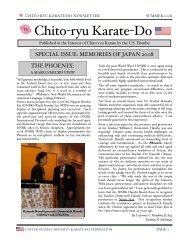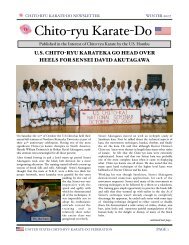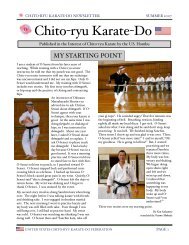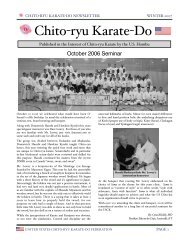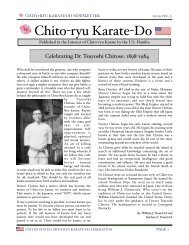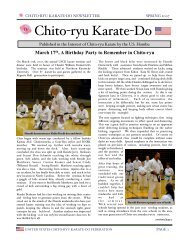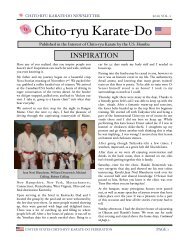newsletter winter 2006 - United States Chito-ryu Karate Federation
newsletter winter 2006 - United States Chito-ryu Karate Federation
newsletter winter 2006 - United States Chito-ryu Karate Federation
You also want an ePaper? Increase the reach of your titles
YUMPU automatically turns print PDFs into web optimized ePapers that Google loves.
CHITO-RYU KARATE-DO NEWSLETTER WINTER <strong>2006</strong><br />
continued 'om previous page…<br />
back. Plus, now I know just how bad my depth perception<br />
is: real bad. So, after the usual bow out, pictures, feast, and<br />
hugs goodbye, another hugely successful Shochugeiko has<br />
been put to bed. Normally after this clinic, I feel like I’ve<br />
done enough karate for the day; time to rest. For some<br />
reason at the end of this one, I was ready to go for another<br />
couple of hours at least….What does that mean? Is that<br />
“success with a capital S” or was it just me? Perhaps<br />
because it turned into such a beautiful day? I give up on<br />
trying to answer that one. Need more proof of success?<br />
Destiny had to admit finally she had a good time…ouch,<br />
that had to hurt!<br />
All I know is: I can’t wait for next <strong>Chito</strong>-kai event….Doki,<br />
Doki.<br />
P.S. Some notable quotables:<br />
“Great weather, great karate!”<br />
“Everyone goes away with something!”<br />
“I wanna train!”<br />
“Stop acting like a yo-yo!”<br />
BOOK REVIEW<br />
By: Gordon Levin<br />
Yoseikan Dojo II of Orlando<br />
Gung Ho! Turn on the People in any Organization.<br />
Ken Blanchard and Sheldon Bowles.<br />
There is a book that is a must read for Dojo Heads<br />
interested in ways to increase membership by fostering<br />
morale in his/her branch club. This book is entitled Gung<br />
Ho, which according to its authors, Ken Blanchard and<br />
Sheldon Bowles, means “working together” in Chinese (p.<br />
63). And this book really laid out a plan for a karate<br />
branch club to work together.<br />
The first point the book makes about working together is<br />
called the “Spirit of the Squirrel.” What this means is that<br />
squirrels work hard because their work is worthwhile, and<br />
so will students when they realize the importance of their<br />
karate training. When they make the realization that<br />
their karate training could save their lives and/or the lives<br />
of the family members. When students realize how<br />
important karate training is they will be willing to double<br />
their efforts in training. The next step is that students<br />
have to understand and share the goal of the branch club<br />
as well as the national organization. According to the<br />
book there is no worthwhile work unless everyone is<br />
working toward a well understood and shared goal. Also,<br />
and maybe even more important is how the goal is<br />
reached. The branch club must be guided by values.<br />
“Goal setting is a big problem in most organization.” The<br />
reason is because administration attempts to impose them<br />
from the top down rather than allowing everyone to share<br />
in the process of setting goals. All club members must<br />
believe that the goals are important. (Leadership can be<br />
defined as finding out where people are going and getting<br />
in front of them and the same can be said for goal setting,<br />
first begin with finding out the goals of the people you<br />
want to set goals with.). This article will now discuss the<br />
second point of the book in the next paragraph.<br />
The second point of the book is “The Way of the Beaver:<br />
In control of achieving the goal.” This means that “[e]ach<br />
beaver has a large measure of control over its own destiny.<br />
They decide how the work is going to be done. They<br />
operate like indecent contractors.” What this quote<br />
means is that each branch club must set its agenda and<br />
this will significantly increase their chances for success. In<br />
other words, it is best to let the people who really do the<br />
work, to do the work. The national organization should<br />
set the key goals and values (i.e. policy manual). Then<br />
allow the branch club to operate within these constraints.<br />
This is based on the premise that people will naturally<br />
work together when given the chance. Thus, the Way of<br />
the Beaver covered the relationship between the<br />
individual and the organization from both sides.<br />
Hopefully, the reader will see the connection between the<br />
Spirit of the Squirrel and the Way of the Beaver. So this<br />
article will move into the third and final point.<br />
The third point of the book is the Gift of the Goose:<br />
cheering others on. The most important point in this<br />
section is that all the geese honk at each other, which<br />
means they all encourage each others on to greater<br />
heights. Thus, each member of the branch club must<br />
cheer each other on to strive for the ultimate achievement<br />
of karate training: self-perfection.<br />
The author of this article hopes that dojo heads will go<br />
out and obtain a copy of Gung Ho and read it. Then they<br />
can begin to implement the three concepts of the Spirit of<br />
the Squirrel, the way of the Beaver, and the gift of the<br />
Geese. This will increase the chances of their branch club<br />
enjoying even more success. As stated in Gung Ho, when<br />
the student is ready, the teacher will show up. And it is<br />
hoped that each and every dojo head will keep their<br />
student hat on and get this book.<br />
By: Wi%ie E%iot, DMin<br />
UNITED STATES CHITO-RYU KARATE-DO FEDERATION PAGE 6



